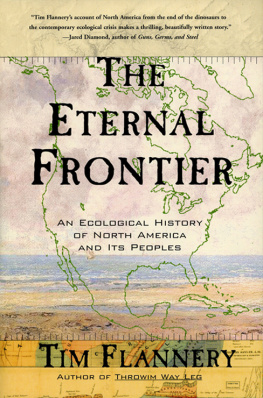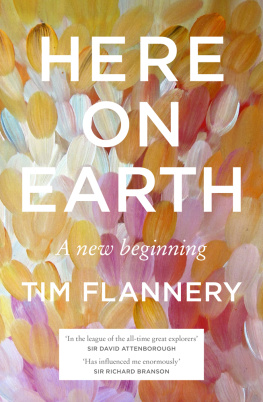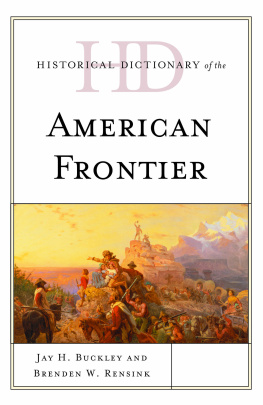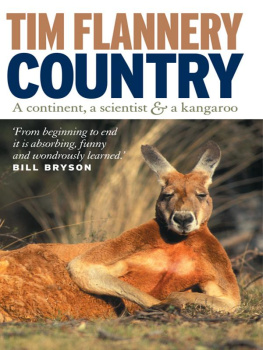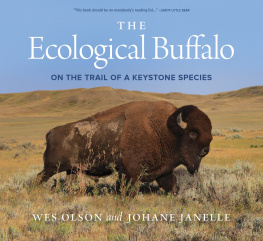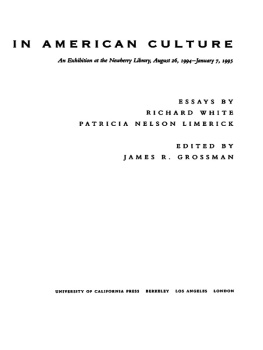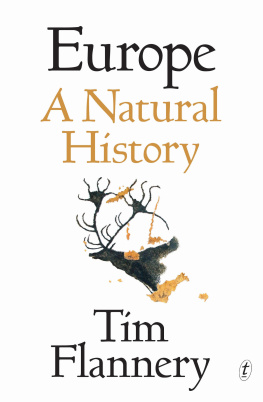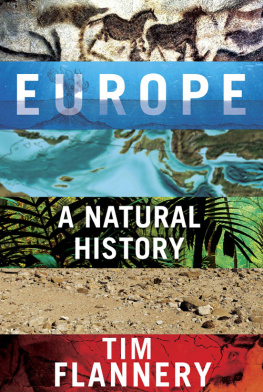
International Acclaim for Tim Flannery's The Eternal Frontier:
Bold... Flannery's chronicle of evolutionary triumphs and setbacks, foreign invasions, and the rise of some continental specialtiessuch as horses, camels, dogs, and even cheetahswould alone make the book worth reading.... Watch out, fellow North Americans. This gutsy Aussie may have read our landscape and ecological history with greater clarity than any native son.David A. Burney, Natural History
A sweeping natural history of North America from its birth as a self-contained continent in the Cretaceous Era to its current precarious status as an ecological superpower ... Natural history par excellence.
Kirkus Reviews (starred review)
Flannery has a talent for imagining prehistoric landscapes and bringing them vividly to life.... A fascinating, current, and insightful look at our familiar history from a larger perspective.
David Bezanson , The Austin American-Statesman
Riveting... A masterpiece of modern science... The Eternal Frontier is nature poetry and cautious science, both at their very best.
The Sunday Telegraph (London)
Splendid... Flannery has been compared to those other popularizers of historical biology, Stephen Jay Gould and Jared Diamond. I think he is superior. He is a better writer than either.... Tim Flannery is the real thing: a man with a gift for lucid exposition, who can really make his subject come alive.Frank McLynn, The Literary Review
Tim Flannery has crafted a masterpiece of science and history. Rich with fascinating and often mind-boggling insights into how the continent of North America developed, this gracefully written book is a must for anyone who has ever marveled at this large and infinitely varied land.
Paul R. Ehrlich, author of Human Nature
Flannery... applies the fluent interdisciplinary approach he used in his ecological history of Australia to the story of North America, a place he finds fascinating for its climatic extremes, rich fossil record, dramatic geologic transformations, and diverse human cultures.... As Flannery makes visible the grand and intricate cycles of evolutionary renaissance and extinction in new and dynamic ways, he foregrounds humanity as the planet's most creative and destructive species.
Donna Seaman, Booklist (starred review)
Astonishing... Flannery ranges far and wide, from Alaska in the frozen north to Panama in the tropical south.... If you only have time to read one book on the natural history of North America, The Eternal Frontier should be your first port of call.
Joseph M. Siracusa, The Courier-Mail (Australia)
Ambitious... Extraordinary... A sweeping, highly original and delightful paleobiogeographical interpretation of this land of eternal frontiers.Paul S. Martin, Bioscience

The Eternal Frontier
OTHER BOOKS BY THE AUTHOR
Mammals of New Guinea
Tree Kangaroos: A Curious Natural History with R. Martin, P. Schouten and A. Szalay
The Future Eaters: An Ecological History of the Autralasian Lands and Peoples
Possums of the World: A Monograph of the Phalangeroidea with P. Schouten
Mammals of the South West Pacific and Moluccan Islands
Watkin Tench, 1788 (ed.)
The Life and Adventures of John Nicol, Mariner (ed.)
Throwim Way Leg
The Explorers (ed.)
The Birth of Sydney
Terra Australis: Matthew Flinders Great Adventures in the Circumnavigation of Australia (ed.)
A Gap in Nature with P. Shouten
The
Eternal
Frontier
An ecological history of North America and its peoples
Tim Flannery

GROVE PRESS
New York
Copyright 2001 by Tim Flannery
All rights reserved. No part of this book may be reproduced in any form or by any electronic or mechanical means, or the facilitation thereof, including information storage and retrieval systems, without permission in writing from the publisher, except by a reviewer, who may quote brief passages in a review. Any members of educational institutions wishing to photocopy part or all of the work for classroom use, or publishers who would like to obtain permission to include the work in an anthology, should send their inquiries to Grove/Atlantic, Inc., 841 Broadway, New York, NY 10003.
First published in 2001 by The Text Publishing Company, Melbourne, Victoria, Australia
ILLUSTRATION SOURCES
Grateful acknowledgment is made to the following for permission to reproduce the illustrative material in the picture sections:
Plate I, painted by Peter Schouten; plate II, Wilbur Garrett/NGS Image Collection; plates III, IV, V and VI, painted by Peter Schouten; plate VII, David Arnold/NGS Image Collection; plate VIII, Michael Nichols/NGS Image Collection; plate IX, University of Alaska; plate X, George Grall/NGS Image Collection; plate XI, Photo Archives, Denver Museum of Nature and Science; plate XII, Library of Congress; plate XIII, Dept. of Library Services, American Museum of Natural History, neg. no. 2A22680; plate XIV, Arizona Historical Society/Tucson, AHS 20602; plate XV, National Cowboy Hall of Fame and Western Heritage Center, Oklahoma City; plate SVI, Burton Historical Collection, Detroit Public Library; plate XVII, from Audubon's Birds of America, La Trobve Collection, State Library of Victoria; plate XVIII, painted by Peter Schouten.
Published simultaneously in Canada
Printed in the United States of America
Library of Congress Cataloging-in-Publication Data
Flannery, Tim F. (Tim Fridtjof), 1956
The eternal frontier : an ecological history of North America and its peoples / Tim Flannery.
p. cm.
First published by Text Publishing, Melbourne, Australia, in 2001.
ISBN-10: 0-8021-3888-8
ISBN-13: 978-0-8021-3888-0
eISBN: 978-0-8021-9109-0
1. Natural historyNorth America. 2. EcologyNorth America. I. Title.
QH102 .F63 2001
508.7dc212001018841
Cover design by Charles Rue Woods
Design by Chong Weng-ho
Maps by Norman Robinson
Grove Press
an imprint of Grove/Atlantic, Inc.
841 Broadway
New York, NY 10003
Distributed by Publishers Group West
www.groveatlantic.com
08 09 10 11 12 10 9 8 7 6 5 4
This project has been assisted by the Government of South Australia through Arts South Australia and by the Commonwealth Government through the Australia Council, its arts funding and advisory body.

To the North Americans:
in admiration of the efforts so many are now making
to win back the natural grandeur, the biodiversity
and ecological balance of their exceptional land.
CONVERSION TABLE
LENGTH
1 centimetre = 0.39 inches
1 metre = 3.28 feet
1 kilometre = 0.62 miles
MASS
1 kilogram = 2.2 pounds
1 tonne = 0.98 ton
AREA
1 hectare = 2.47 acres
1 square kilometre = 0.39 square miles
VOLUME
1 cubic kilometre = 0.24 cubic miles
TEMPERATURE
F = (C 1.8)+ 32
Contents
A most unfortunate day for North America 65 million years ago.
Mr Kyte's flying fragment. The importance of the celestial chip shot and the awful fate of the divot. The vegetable dinosaurs of the south and the Arctic north, and the extinction of the real thing.
Bizarre goings-on in a disordered world and a tale of wandering continents. The Malayan climbing fern takes over.
Next page
